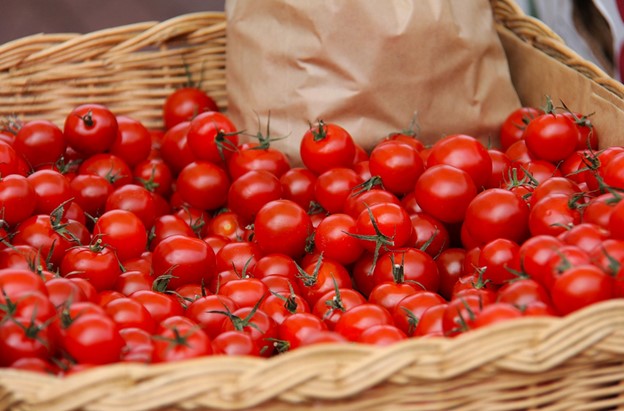Cherry tomatoes need an ideal place to stay fresh and delicious, and finding the perfect storage spot will make a big difference in their shelf life. So, it’s important to look for the optimal storage conditions for cherry tomatoes so that they can significantly influence their longevity and flavor.
These succulent bursts of flavor quickly lose their taste and become mushy, so some unique storage needs can significantly impact their texture as well as the flavor and help you enjoy their taste for a long period.
Let us now dive into some of the best techniques for storing these tiny, bursting jewels of flavor. We will provide you with the essential tips and tricks to prevent cherry tomatoes from getting spoiled.
So, learn to store ripe cherry tomatoes like a pro!
Best Ways To Store Fresh Cherry Tomatoes
Table of Contents

Below are some of the methods for effectively storing whole tomatoes and maintaining their freshness and flavor. To get a clear idea about What To Do With The Abundance Of Cherry Tomatoes, read through this detailed guide.
Go through the ways to store fresh tomatoes so that they last longer.
1. Room Temperature
At room temperature, cherry tomatoes can easily be stored for up to a week in a container. They should be kept away from direct sunlight, which will allow them to ripen naturally and help maintain their flavor.
They can be stored in cardboard boxes or a shallow bowl in a single layer out of direct sunlight.
2. Refrigerator
Refrigerating cherry tomatoes extends their shelf life up to two weeks, so they should be placed in a sealed plastic bag or even in a container. However, it is highly recommended to consume cherry tomatoes soon after chilling, as refrigerating results in a loss of flavor.
It is better to store perfectly ripe cherry tomatoes in the fridge without washing them, as moisture can promote mold growth.
3. Freezing
For long-term storage, freezing cherry tomatoes in the freezer is the ideal method. First, wash the tomatoes, remove the stems, and spread them in a single layer on top of a baking sheet. Then, freeze them until they become solid. After they become frozen, transfer them to a freezer bag or container.
Freeze the tomatoes until they turn solid, usually 2-3 hours, and add them directly to soups or sauces.
4. Sun-Drying Or Oven-Drying

Cherry tomatoes can also be preserved by sun-drying or oven-drying. This method is easy to do, and it involves using a dehydrator or roasting them at a low temperature in the oven and then storing them in airtight containers.
To roast tomatoes in the oven, you need to place the fully ripe tomatoes on top of a baking sheet, put them in the oven, and wait for them to dry. The roasted cheery tomatoes will need to be at around 135 degrees Fahrenheit and will usually take around 6-8 hours.
5. Ventilated Storage
Ventilated storage is another method where the cherry tomatoes are placed in a well-ventilated storage area to maintain the humidity levels, thus helping prevent spoilage. The best and easiest ways to store cut tomatoes are discussed here.
Signs That Cherry Tomatoes Have Gone Bad
Key indicators that help you recognize the signs of spoilage:
- Discoloration
- Wrinkled Or Shriveled Skin
- Mold Growth
- Soft Or Mushy Texture
- Bad Or Unpleasant Odor
- Slimy Texture
- Internal Changes
How Do You Prevent Cherry Tomatoes From Going Bad?
To extend the shelf life of cherry tomatoes, users can follow these storage and handling tips to prevent them from going rancid.
So, follow these tips and keep your cherry tomatoes fresh for as long as it is possible:
1. Store At Room Temperature

Avoid refrigerating the cherry tomatoes. Instead, store them at room temperature and consume them within a few days. Refrigeration will impact the flavor and, in turn, cause them to lose their original texture.
It is best to store them at room temperature, away from direct sunlight, in a cool and dark place.
2. Avoid Washing Until Ready To Use

Washing tomatoes will add moisture to the surface, creating a conducive environment for bacterial growth and further instigating the spoilage process.
3. Inspect Regularly For Damage
Check the tomatoes regularly for damage and signs of mold growth. Remove bruised or damaged tomatoes or those showing signs of mold. It is equally essential to separate the overripe tomatoes, as the ethylene gas emitted from them will accelerate the ripening of other tomatoes.
4. Store In Breathable Containers
Avoid storing the tomatoes in an airtight container. Instead, use a breathable container that will allow proper air circulation and won’t trap moisture. Using paper towels will also help to absorb the excess moisture and prevent mold from forming.
5. Avoid Stacking
Stacking the tomatoes on top will exert pressure on the tomatoes that are present below, resulting in bruising, especially if the tomatoes are soft or overripe.
Excessive pressure and bruising will damage the delicate skin of the tomatoes and will create cracks or breaks that are more susceptible to bacterial and fungal infections.
Final Words
If stored properly in the right conditions, these bite-sized juicy tomatoes will extend their shelf life, and you will be able to enjoy them in your favorite recipes by incorporating them into your dishes.
So, understand the various storage methods, extend their shelf life with the correct technique, and enjoy the sweetness and tanginess for weeks.
Leave a Reply